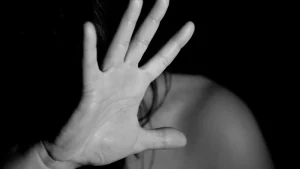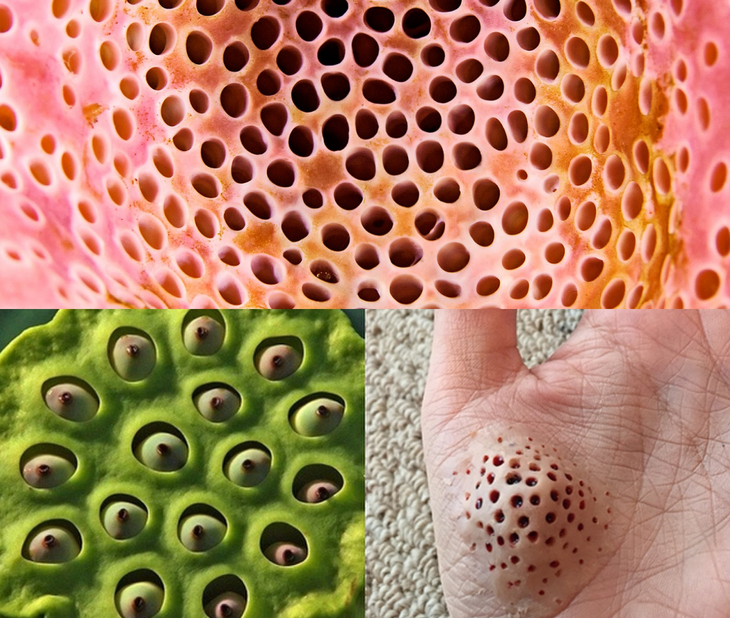Trypphobia is the fear or disgust of seeing round holes. People with this disorder feel uncomfortable when looking at surfaces with small holes clustered together. For example, the top of a lotus seed or the stem of a strawberry can cause discomfort in people with this syndrome. Currently, research on trypophobia is still limited and is not recognized as a psychological disorder.
1. “Just Holes” or a Deep Psychological Fear? What Is Trypophobia Really?
Does seeing a honeycomb, a sponge, or a soap bubble make you shiver, feel scared, or… You may have Trypophobia, or the fear of holes.
The name of this syndrome comes from the Greek words “trypta” meaning hole and “phobos” meaning fear. But the term does not date back to ancient Greece. “Trypophobia” first appeared on a web forum in 2005.
Trypophobia is one of many fears of harmless things, such as fear of small round holes, fear of hair, or fear of small things. People with trypophobia have strong physical and emotional reactions whenever they see patterns made of holes or spots. The larger the cluster of circles, the more uncomfortable they feel.

Researchers disagree about whether trypophobia should be classified as a true phobia. A 2013 book on trypophobia suggested that the phobia may be an extension of a biological fear of harmful things. Researchers found that symptoms were triggered by high-contrast colors in a certain graphic arrangement. They suggested that people with trypophobia subconsciously associate harmless objects, such as lotus seed pods, with dangerous animals, such as the blue-ringed octopus.
Another book on trypophobia published in April 2017 raised the issue. Researchers surveyed preschoolers to determine whether the fear of seeing images with small holes was based on a fear of dangerous animals or a response to visual features. Their results showed that people who experience trypophobia do not have an unconscious fear of venomous creatures. Instead, the fear is triggered by the creature’s presence.
The American Psychiatric Association’s Diagnostic and Statistical Manual of Mental Disorders, (DSM-5) does not recognize trypophobia as an official phobia. More research is needed to understand the full scope of trypophobia and what causes it.
Trypophobia is more common in women than men. In one study, about 25% of people with trypophobia also had a relative with the condition.
A 2017 study on trypophobia found a possible link between trypophobia and major depressive disorder and generalized anxiety disorder (GAD). According to the researchers, people with trypophobia were more likely to also have major depressive disorder or GAD. Another study published in 2016 also noted a link between social anxiety and trypophobia.
Some people with trypophobia may also have other mental health disorders, such as:
- Major depression
- Generalized anxiety disorder (GAD)
- Anxiety
- Panic disorder
- Obsessive-compulsive disorder (OCD)
- Bipolar disorder
2. From Goosebumps to Panic: How Trypophobia Shows Itself
Symptoms of trypophobia look a lot like a panic attack. Some of the symptoms that may appear include:
- Nausea
- Shortness of breath
- Rapid heartbeat
- Sweating
- Itching, goose bumps
- Feeling uncomfortable
- Visual discomfort such as eye strain, hallucinations, etc.
- Depression
- Body shaking
- People with trypophobia may experience these symptoms several times a week or every day. In some cases, the fear of holes never goes away.

3. Triggers for Trypophobia
Some things that can trigger trypophobia include:
- Hole or pebbles in concrete
- Air holes in a slice of bread
- Patterns in the frosting of a cake or pie
- Lotus heads
- Hole in an old hockey mask
- Skin problems such as sores, scars, and spots
- Mottled animals
- Shower heads
- LED lights in traffic lights
- Lotus seed pods
- Honey
- Strawberries
- Coral
- Aluminium foam
- Pomegranate
- Bubbles
- Condensation
- Cantaloupe
- Eyes
- Animals, including insects, amphibians, mammals, and other creatures with spotted skin or fur, can also trigger symptoms of trypophobia.

4. Treating Trypophobia
There are many different ways to treat trypophobia. The most effective form of treatment is exposure therapy. Exposure therapy is a type of psychotherapy that focuses on changing your response to the object or situation that triggers your fear.
Another common form of treatment for trypophobia is cognitive behavioral therapy (CBT). CBT combines exposure therapy with other strategies to help you manage your anxiety and keep your thoughts from becoming overwhelming.
Some other treatments that can help you manage your phobia include:
- Talking to a counselor or psychiatrist
- Using medications such as beta blockers and tranquilizers to help reduce anxiety and panic symptoms
- Using relaxation techniques, such as deep breathing and yoga
- Regular physical activity and exercise to control anxiety
- Practicing mindful breathing, observing, listening, and other mindfulness strategies to help cope with stress and anxiety.
- Medications used to treat other types of anxiety disorders are not effective in treating trypophobia.
The following measures may also help reduce the effects of trypophobia, such as:
- Get plenty of rest
- Eat a balanced diet
- Avoid caffeine and other stimulants that make anxiety worse
- Reach out to friends and family to connect with others who have the same condition
- Regularly expose yourself to the most frightening situations possible.
Trypophobia is not an officially recognized mental illness. Some researchers have found evidence that it exists in some form and has real symptoms that can interfere with a person’s daily life if they are exposed to triggers.
If you think you might have trypophobia, talk to a healthcare professional. They can help you uncover the root of the fear and guide you toward the best strategies to manage it.


